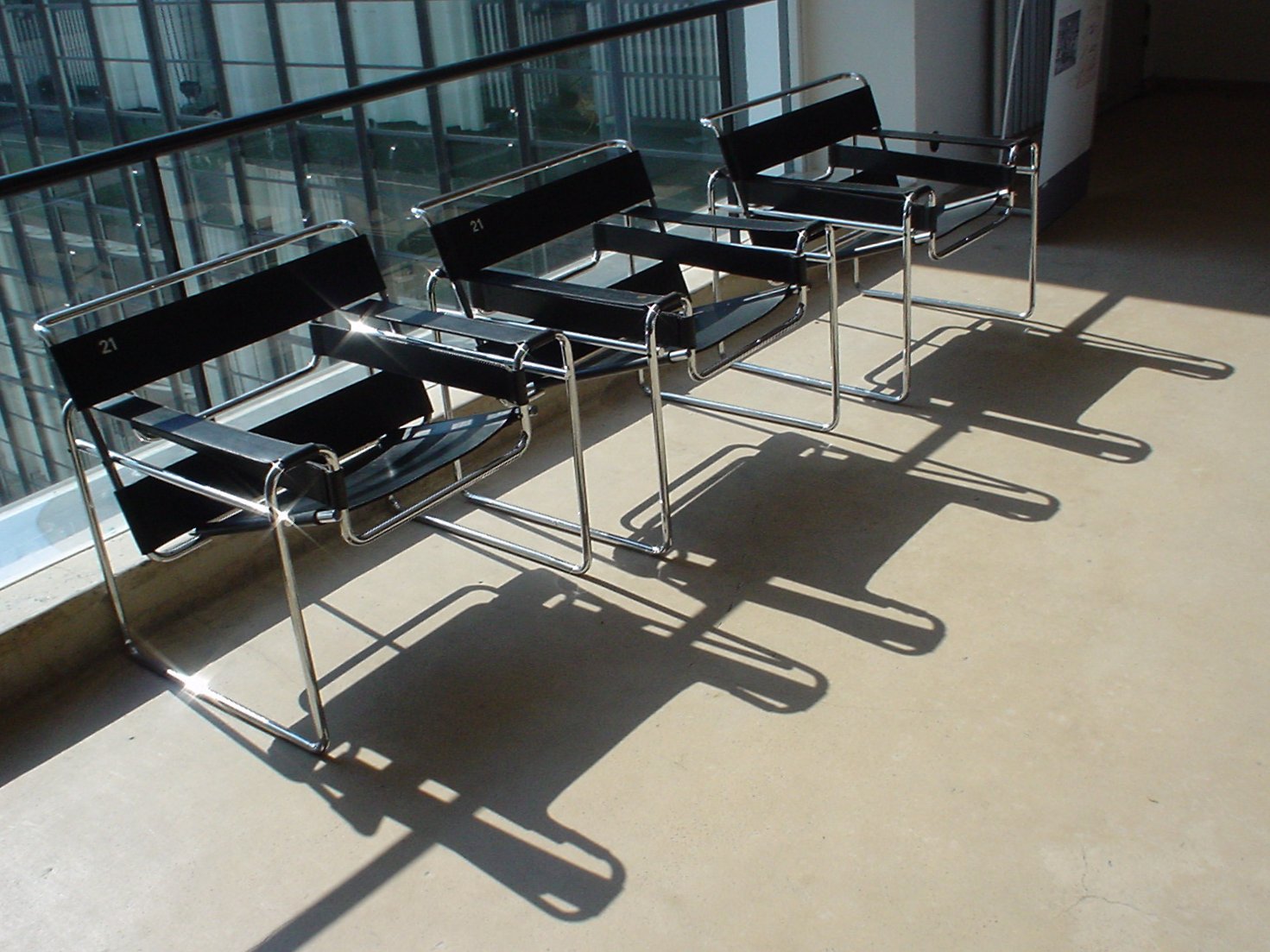|
Lilly Reich
Lilly Reich (16 June 1885 – 14 December 1947) was a German designer of textiles, furniture, interiors, and exhibition spaces. She was a close collaborator with Ludwig Mies van der Rohe for more than ten years during the Weimar period in the 1920s and early 1930s. Reich was an important figure in the early Modern Movement in architecture and design. Her fame was posthumous, as the significance of her contribution to the work of Mies van der Rohe and others with whom she collaborated only became clear through the research of later historians of the field. Biography Reich was born in Berlin on 16 June 1885. In 1908, she put her embroidery training to use when she went to Vienna to work for the Wiener Werkstätte (Vienna Workshop) of Josef Hoffmann, a visual arts production company of designers, artists, and architects. She returned to Berlin by 1911. There she began to design furniture and clothing. She also worked as a shop window decorator at this time. The following year ... [...More Info...] [...Related Items...] OR: [Wikipedia] [Google] [Baidu] |
Barcelona Chair
The Barcelona chair is a chair designed by Ludwig Mies van der Rohe and Lilly Reich, for the German Pavilion at the International Exposition of 1929, hosted by Barcelona, Catalonia, Spain. The chair was first used in Villa Tugendhat, a private residence, designed by Mies in Brno (Czech Republic). Materials and manufacture The frame was initially designed to be bolted together but was redesigned in 1950 using stainless steel, which allowed the frame to be formed by a seamless piece of metal, giving it a smoother appearance. Bovine leather replaced the ivory-colored pigskin which was used for the original pieces. Philosophy and ergonomics Although many architects and furniture designers of the Bauhaus era were intent on providing well-designed homes and impeccably manufactured furnishings for the "common man," the Barcelona chair was an exception. It was designed for the Spanish Royalty to oversee the opening ceremonies of the exhibition and was described by Time magazine as ... [...More Info...] [...Related Items...] OR: [Wikipedia] [Google] [Baidu] |
Interior Design
Interior design is the art and science of enhancing the interior of a building to achieve a healthier and more aesthetically pleasing environment for the people using the space. An interior designer is someone who plans, researches, coordinates, and manages such enhancement projects. Interior design is a multifaceted profession that includes conceptual development, space planning, site inspections, programming, research, communicating with the stakeholders of a project, construction management, and execution of the design. History and current terms In the past, interiors were put together instinctively as a part of the process of building.Pile, J., 2003, Interior Design, 3rd edn, Pearson, New Jersey, USA The profession of interior design has been a consequence of the development of society and the complex architecture that has resulted from the development of industrial processes. The pursuit of effective use of space, user well-being and functional design has contributed ... [...More Info...] [...Related Items...] OR: [Wikipedia] [Google] [Baidu] |
Knoll (company)
Knoll (previously Knoll Inc., now a subsidiary MillerKnoll, Inc.), is an American company that manufactures office systems, seating, storage systems, tables, desks, textiles, as well as accessories for the home, office, and higher education. The company is the licensed manufacturer of furniture designed by notable architects and designers such as David Adjaye, Harry Bertoia, Ludwig Mies van der Rohe, Florence Knoll, Frank Gehry, Charles Gwathmey, Maya Lin, Marc Newson, Ini Archibong, Eero Saarinen, and Lella and Massimo Vignelli, under the company's KnollStudio division. Over 40 Knoll designs can be found in the permanent design collection of the Museum of Modern Art in New York City. History The company was founded in New York City in 1938 by Hans Knoll. Production facilities were moved to Pennsylvania in 1950. After the death of Hans in 1955, his wife Florence Knoll took over as head of the company. The company is headquartered in East Greenville, Pennsylvania and h ... [...More Info...] [...Related Items...] OR: [Wikipedia] [Google] [Baidu] |
Brno Chair
The Brno chair (model number MR50) is a modernist cantilever chair designed by Ludwig Mies van der Rohe and Lilly Reich in 1929-1930 for the bedroom of the Tugendhat House in Brno, Czech Republic. The design was based on similar chairs created by Mies van der Rohe also working with Lilly Reich, such as the MR20 chair with wicker seat from 1927; all building on earlier designs of Mart Stam. The Brno chair has become a modern furniture classic. It has very clean lines, consisting of a steel frame in a single piece, bent into a C-shape from the middle of the back, round past the front edge of seat (to create arms), and back under the seat to create a cantilever, with taut seat and back upholstered in leather. There are two versions of the chair, one in tubular steel and the other in flat steel. The metal was originally polished stainless steel; some modern examples are chrome plated. The Brno chair was selected by Dan Cruickshank as one of his 80 man-made "treasures" in the ... [...More Info...] [...Related Items...] OR: [Wikipedia] [Google] [Baidu] |
Barcelona Chair
The Barcelona chair is a chair designed by Ludwig Mies van der Rohe and Lilly Reich, for the German Pavilion at the International Exposition of 1929, hosted by Barcelona, Catalonia, Spain. The chair was first used in Villa Tugendhat, a private residence, designed by Mies in Brno (Czech Republic). Materials and manufacture The frame was initially designed to be bolted together but was redesigned in 1950 using stainless steel, which allowed the frame to be formed by a seamless piece of metal, giving it a smoother appearance. Bovine leather replaced the ivory-colored pigskin which was used for the original pieces. Philosophy and ergonomics Although many architects and furniture designers of the Bauhaus era were intent on providing well-designed homes and impeccably manufactured furnishings for the "common man," the Barcelona chair was an exception. It was designed for the Spanish Royalty to oversee the opening ceremonies of the exhibition and was described by Time magazine as ... [...More Info...] [...Related Items...] OR: [Wikipedia] [Google] [Baidu] |
Brno
Brno ( , ; german: Brünn ) is a city in the South Moravian Region of the Czech Republic. Located at the confluence of the Svitava and Svratka rivers, Brno has about 380,000 inhabitants, making it the second-largest city in the Czech Republic after the capital, Prague, and one of the 100 largest cities of the EU. The Brno metropolitan area has almost 700,000 inhabitants. Brno is the former capital city of Moravia and the political and cultural hub of the South Moravian Region. It is the centre of the Czech judiciary, with the seats of the Constitutional Court, the Supreme Court, the Supreme Administrative Court, and the Supreme Public Prosecutor's Office, and a number of state authorities, including the Ombudsman, and the Office for the Protection of Competition. Brno is also an important centre of higher education, with 33 faculties belonging to 13 institutes of higher education and about 89,000 students. Brno Exhibition Centre is among the largest exhibitio ... [...More Info...] [...Related Items...] OR: [Wikipedia] [Google] [Baidu] |
Tugendhat House
Villa Tugendhat is an architecturally significant building in Brno, Czech Republic. It is one of the pioneering prototypes of modern architecture in Europe, and was designed by the German architects Ludwig Mies van der Rohe and Lilly Reich. It was built between 1928 and 1930 for Fritz Tugendhat and his wife Greta, of the wealthy and influential Jewish Tugendhat family. Of reinforced concrete,Courland, Robert. ''Concrete Planet''. Prometheus Books, Amherst, NY. (2012) p. 326. ISBN 978-1616144814. the villa soon became an icon of modernism. Famous for its revolutionary use of space and industrial building materials, the building was added to the UNESCO World Heritage List in 2001. Design The free-standing three-story villa is on a slope and faces the south-west. The second story (the ground floor) consists of the main living and social areas with the conservatory, the terrace, the kitchen and servants' rooms. The third story (the first floor) has the main entrance from the str ... [...More Info...] [...Related Items...] OR: [Wikipedia] [Google] [Baidu] |
Barcelona Pavilion
The Barcelona Pavilion ( ca, Pavelló alemany; es, Pabellón alemán; "German Pavilion"), designed by Ludwig Mies van der Rohe and Lilly Reich, was the German Pavilion for the 1929 International Exposition in Barcelona, Spain. This building was used for the official opening of the German section of the exhibition. It is an important building in the history of modern architecture, known for its simple form and its spectacular use of extravagant materials, such as marble, red onyx and travertine. The same features of minimalism and spectacular can be applied to the furniture specifically designed for the building, including the Barcelona chair. It has inspired many important modernist buildings. Concept Mies and Reich were offered the commission of this building in 1928 after his successful administration of the 1927 Werkbund exhibition in Stuttgart. The German Republic entrusted Mies with the artistic management and erection of not only the Barcelona Pavilion, but for t ... [...More Info...] [...Related Items...] OR: [Wikipedia] [Google] [Baidu] |
Modern Furniture
Modern furniture refers to furniture produced from the late 19th century through the present that is influenced by modernism. Post-World War II ideals of cutting excess, commodification, and practicality of materials in design heavily influenced the aesthetic of the furniture. It was a tremendous departure from all furniture design that had gone before it. There was an opposition to the decorative arts, which included Art Nouveau, Neoclassical, and Victorian styles. Dark or gilded carved wood and richly patterned fabrics gave way to the glittering simplicity and geometry of polished metal. The forms of furniture evolved from visually heavy to visually light. This shift from decorative to minimalist principles of design can be attributed to the introduction of new technology, changes in philosophy, and the influences of the principles of architecture. As Philip Johnson, the founder of the Department of Architecture and Design at the Museum of Modern Art articulates: "Today industr ... [...More Info...] [...Related Items...] OR: [Wikipedia] [Google] [Baidu] |
Newark, New Jersey
Newark ( , ) is the List of municipalities in New Jersey, most populous City (New Jersey), city in the U.S. state of New Jersey and the county seat, seat of Essex County, New Jersey, Essex County and the second largest city within the New York metropolitan area.New Jersey County Map New Jersey Department of State. Accessed July 10, 2017. The city had a population of 311,549 as of the 2020 United States census, 2020 U.S. census, and was calculated at 307,220 by the Population Estimates Program for 2021, making it List of United States cities by population, the nation's 66th-most populous municipality. [...More Info...] [...Related Items...] OR: [Wikipedia] [Google] [Baidu] |
German Werkbund
The Deutscher Werkbund (English: "German Association of Craftsmen"; ) is a German association of artists, architects, designers and industrialists established in 1907. The Werkbund became an important element in the development of modern architecture and industrial design, particularly in the later creation of the Bauhaus school of design. Its initial purpose was to establish a partnership of product manufacturers with design professionals to improve the competitiveness of German companies in global markets. The Werkbund was less an artistic movement than a state-sponsored effort to integrate traditional crafts and industrial mass production techniques, to put Germany on a competitive footing with England and the United States. Its motto ''Vom Sofakissen zum Städtebau'' (from sofa cushions to city-building) indicates its range of interest. History The Deutscher Werkbund emerged when the architect Joseph Maria Olbrich left Vienna for Darmstadt, Germany, in 1899, to form an a ... [...More Info...] [...Related Items...] OR: [Wikipedia] [Google] [Baidu] |



.jpg)





